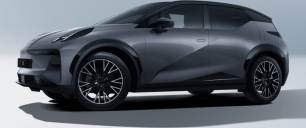The cabin up front features plenty of leg- and headroom as well as cleverly designed storage options.
The rear row is surprisingly comfortable for space behind my driving position but I'm only 168cm tall and it might get squishy if you're behind taller front occupants. It's best to think of this car as a four-seater for adults though, the middle seat is an emergency seat.
The seats themselves are very comfortable for long trips, and both are powered and feature heat functions. My favourite feature inside are the door handles - easy to use and they look great too.
Like I mentioned earlier, the design is rather intuitive to use for every day. The only controls in the cabin are the window buttons and they're discreetly placed on either end of the middle console. The front only feature two buttons but you can switch them over for the rear window use via a little touchpad.
Individual storage is great for the class, with a large open centre console that features a dual opening lid with a shallow cubby, which is perfect to hide away any charging cables for the two USB-C ports.
There is a dedicated phone storage space in the form of a 'lean-to' scenario which also features the wireless charging pad and it's large enough to accommodate bigger devices like an iPad.
There is a sneaky glove box which is located underneath the multimedia screen but it irks me that you can only open it via the screen. It's large enough to hold a manual.
The other sneaky but super handy element is the retractable cupholder shelf that slides away into the middle console. You can also position it so only one cupholder is available or slide the cupholder insert backwards for a large cubby.
The rear gets large storage bins in each door, a drawer from the centre console but it's disappointing that the rear row misses out on cupholders or an armrest for added comfort. It does get two USB-C ports.
There is a 7L frunk storage plus the boot is adequate for overnight luggage or a grocery run with its 318L of capacity but that can jump up to 904L if you fold the rear row.
The multimedia system is fairly easy to use but you have to get used to it as it's a bit different from other Volvo systems I've sampled in the past. You also have to get used to accessing everything for the car, even for turning the car off, via the screen. I do like having buttons/dials but not having them in the EX30 mostly works.





